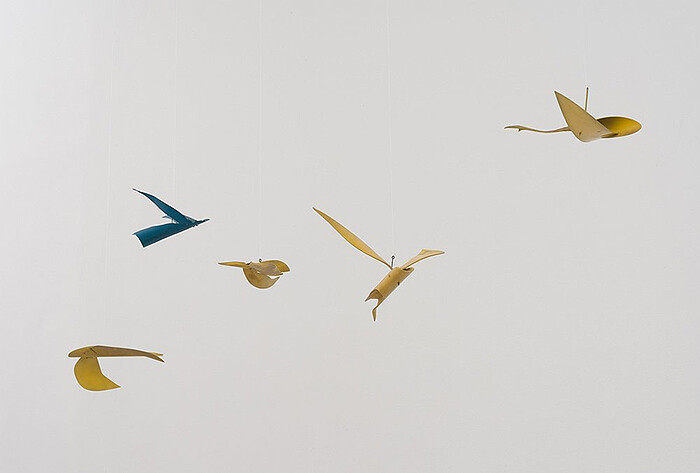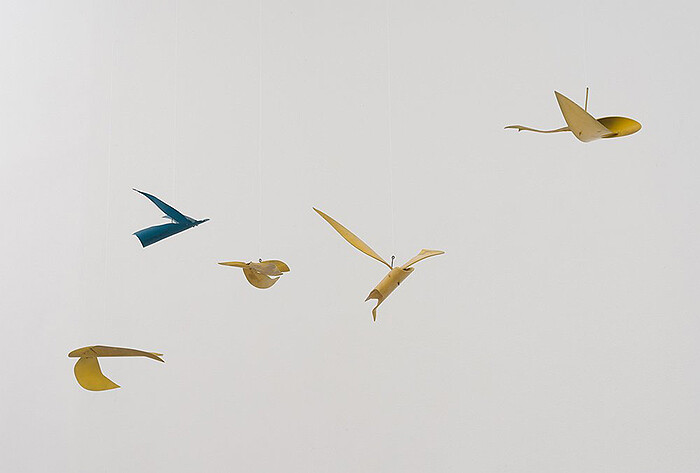Whatever their intentions, posthumous gallery exhibitions rarely feel sincerely elegiac. Even the most reverential show can make the cynic in us suspect efforts to stoke the market for the master’s remnants. This is not the case here. In contrast to the citywide retrospection of “Pacific Standard Time,” the current bonanza of exhibitions celebrating (and, more to the point, often promoting) the region’s artistic heritage, this exhibition of works by the American painter and sculptor David von Schlegell (1920–1992) seems to direct its gaze as much inward as backward. Thumbing through the press binders, filled with personal snapshots, newspaper clippings about von Schlegell’s dauntless air force service, and black-and-white installation shots of von Schlegell’s public works, I’m suddenly very aware that I am perusing not the press, but the family archives.
Organized with the help of that family—writer Mark von Schlegell, painter R.H. Quaytman, and poet Susan Howe—this exhibition gathers together monochrome paintings from his final years as well as models and sketches of his public sculptures. There is also a single supine piece of carved rosewood from 1988, whose burly underside belies a finely notched ridge that runs along its upper edge like delicate wainscoting. The piece is evocative of the kind of skilled domestic woodwork that marks the beginning of his career: though trained as a painter, von Schlegell began making sculpture after building his own house in the early sixties. But it was when he gave up on wood and started employing industrial materials and aeronautical forms that von Schlegell entered the minimalist narrative, notably participating in Kynaston McShine’s canonical “Primary Structures” (1966) before going on to show with Pace Gallery and execute a number of radiant minimal public sculptures while serving on the art faculty at Yale.
Yet the tale told by this exhibition is less public and less timely. Hanging near the show’s entrance is a study for a work von Schlegell never completed: five birds made out of painted aluminum (Five Birds [1988]), suspended beside five paper bird silhouettes, as though the sculptures had flapped themselves free of the paper. This beatific leave-taking makes plain the sculptor’s indebtedness to Matisse, a commitment that somewhat muddles his pedigree. His stepdaughter Quaytman once remarked that von Schlegell’s work was “minimalism with one foot in modernism.” Indeed, elegantly astride that threshold are von Schlegell’s paintings, made from poured Polyur and oil paint: travestied monochromes, flat in material and gesture but nonetheless conjuring up deep pictorial space. In Cerulean Blue, Light to Dark (1992), two “pours” meet in a bleary diagonal seam that plunges into blue depths. In Grey Towards Green (1991), the overlays of green and grey result in a faint crosshatching, as though a fine linen veil had been drawn across the humid surface of the painting. The actual depth of the paintings—about the thickness of a canvas—produces a view that seems at once magnified and forever out of range.
This play of scale occurs more directly in the other works in the show: the models and sketches of large outdoor sculptures, such as the two streamer-headed posts, as disarming in miniature as they are in a photograph taken at Storm King in 1970, or the two models for von Schlegell’s 1983 Pilot’s Memorial in Tulsa, whose homage now includes its author. The decision to show the models, while providing a practical solution to the impossibility of showing these works on the West Coast, acknowledges another distance, far harder to collapse, between Los Angeles’s electric inelegance and von Schlegell’s excessive late minimalism, between Culver City and Storm King, between this moment and times past. After all, looking at something from a different time is not so unlike looking at something in a different scale: both require a leap that is less about picturing the object here than envisioning yourself elsewhere. Von Schlegell’s models don’t reconstitute his sculptures, nor are they surrogates; what they provide instead is an occasion to imagine oneself closer to what remains “forever out of range.” There is a difference between retrospection and resurrection. Art may never be capable of the latter, but there are few things like it than can transport us so sweetly back to what we’ve lost.






